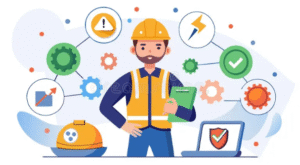How HIRA Strengthens Incident Response- Including the Resource Management Task That Enables Full Coordination

Safety problems can bring substantial negative impact on an organization. Without proper risk assessments, for example, you may expose your workers unnecessarily to harm their health. So, before establishing a safety platform and best practices list for your organization, be sure you have completed a thorough hazard identification with risk assessment in order to set the ground for safety policies. Embedding a safety culture that contributes to employees’ and business aspects of an enterprise.
Which Resource Management Task Enables Resource Coordination Throughout the Incident?
Resource management task enables resource coordination throughout the incident by resource tracking, and here are the following details-
Resource Tracking
- Purpose- The purpose is to account for all resources and know their status at any time.
- Mechanism- This includes keeping complete logs and real-time resource tracking, whether human or material, which has been deployed in the management of the incident.
- Tracking can be done through the use of tools like GPS devices, resource tracking software, or manual logs.
Reporting Resources
- Purpose- To keep all interested parties informed about the status and resource availability regularly.
- Mechanism- Review reports that should cover the deployment, usage, and state of resources to inform the decision-makers on what should be changed in strategies and what needs to be done with resources.
- This reporting can be done through daily briefings, situation reports, and communication platforms such as emails or incident management systems.
Coordination
- Purpose- The purpose is to ensure smooth interaction and coordination across all response teams and stakeholders involved.
- Mechanism Coordination includes communicating with resource managers and incident commanders on the distribution of resources and their effective use at the incident site.
- This may include frequent coordination meetings, regular status updates, and mutually available tracking data via integrated systems.

Best Practices for Hazard Identification and Risk Assessment Audits?
HIRA stands for Hazard Identification and Risk Assessment. HIRA is one of the key processes in maintaining safety at the workplace. It systematically identifies potential hazards and assesses the associated risks to reduce workplace incidents, injuries, and health problems. The importance of HIRA in building a safer work environment cannot be overemphasized. Identification of hazards and risk assessment are two major processes that are essentially required to maintain a high level of safety and efficiency in the workplace. These processes aim at identifying the probable risks and hazards that exist, assessing their severity by putting the management teams in a better position to institute controls, and preventive and corrective actions.
This also improves the breadth of hazard identification and instills more ownership and responsibility for safety with the employees. A combination of qualitative and quantitative risk assessment methods can be applied to achieve a deep understanding of the potential risks. Qualitative methods, such as risk matrices or risk scoring, provide for a speedy evaluation of risks according to their severity and likelihood, whereas quantitative methods, including probabilistic risk assessment or consequence modelling, give a detailed analysis of specific hazards. The regular review and validation of the HIRA findings with relevant stakeholders will make sure that the identified hazards and assessed risks are in line with the operational realities of the organization.

What Are the Benefits of Effective Tracking and Reporting?
Improved Situational Awareness- Resource tracking allows for the maintenance of a better situational awareness, which is a key component in informed decision-making.
Optimal use of Resources- Ensures the resources are not wasted and are channelled to where they are most needed.
Accurate Accountability- It helps to have transparency and accountability for resources deployed. This becomes much more serious in legal and financial contexts after the incident has taken place.
Efficient Incident Response- As coordination improves, the emerging needs and changes in the incident scenario are responded to in a timelier and more effective manner.
Increased Accountability- Regular reporting makes teams more accountable. It keeps track of the status of any project. This encourages and helps team members to work accordingly and not delay the deadlines.
Improved Decision-Making- Regular reporting supports a decision-making system with data-driven insight. A close look at the data will help companies avoid guesswork, hence reducing bias to a minimum. Decisions based on such reasoning will also align well with actual results and market trends.
Data-Driven Insights- Good reporting of data in organizations manifests itself through trends, patterns, and links. It allows the leadership to understand how they are performing against their goals with a good degree of accuracy. By frequently analyzing data, they can establish goals that are realistic and evidence-based.
Improved Transparency- Regular reporting brings a host of benefits, like making sure stakeholders know how things are going. It makes the project evident to everyone. This helps with stakeholder engagement and all that makes the project more likely to be successful.
Expense Tracking- Adding financial monitoring to project management allows one to view the actual picture of costs. In such a way, managers can monitor spending and instantly identify significant variances. Using cloud tools and advanced technologies, cost and expense tracking becomes more accurate.
Consistency in Updates- This helps the project management team provide current updates on time. The whole process of managing the project becomes transparent and trustworthy. Regular reports may also be helpful for audits and loan applications.
Reducing Misunderstandings- Misunderstanding one another causes lapses and wastes time; good communication helps avoid such problems. It builds a place where each person is free to air their ideas.
The Role of Communication in Resource Coordination
Effective communication is the foundation upon which resource coordination happens. In resource coordination, information about the availability of resources, needs, and constraints gets exchanged among various parties. This flow of information must be clear, timely, and accurate in nature for efficiency in the deployment of resources. Communication in resource coordination also refers to understanding the needs and capabilities of different entities.
This mutual understanding is vital to ensure that resources are marshalled in line with the specific demands of an incident to avoid redundancy and ensure that any resource gaps are suitably filled. Good documentation and record keeping are complementary aspects of a successful HIRA audit. Detailed documentation of the identified hazards, assessed risks, and proposed measures for control provides a very useful reference toward sustained safety management and compliance with relevant regulations. Periodic review and updating of the HIRA documentation keep the document relevant and current with respect to evolving conditions within the workplace.
The concept of an efficient incident response team is vital in the context of organizational information security. Attacks are becoming larger, more complex, and frequent. This calls for a capability for timely detection, analysis, and response. Incident detection and analysis are the basic processes of incident response.
Advanced monitoring through Intrusion Detection Systems and techniques such as log analysis will help an organization detect potential security breaches as early as possible. The capability of incident analysis assures thorough insight into attack vectors applied by threat actors.
Conclusion
Resource coordination is one of the most indispensable tasks within the context of resource management during incidents. Resource coordination, through better communication, sound decision-making, and cooperative effort, maximizes the mitigation of incident impact while making the response to emergencies more effective. As incidents pose increasingly complex challenges, the value of resource coordination within resource management becomes increasingly more apparent, and thus entails the need for continuous enhancement and innovation in this field.



